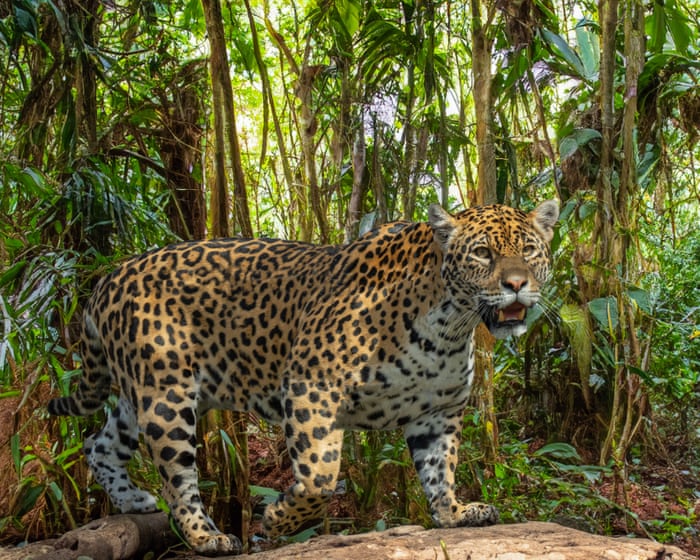In 2010, Gerardo Ceballos and a team of researchers set out to answer a pressing question: how many jaguars were left in Mexico? They knew the numbers were low. Hunting, habitat loss, conflicts with cattle ranchers, and other threats had pushed the species to the edge of extinction.
Ceballos and his colleagues from the National Alliance for Jaguar Conservation (ANCJ) estimated there might be around 1,000 jaguars nationwide. To get an accurate count, they conducted Mexico’s first-ever jaguar census. The results were a surprise: they found 4,100 jaguars.
“It was a wonderful surprise—terrific news,” Ceballos said. “Of course, 4,000 still means the species is endangered, but it’s a lot better than 1,000.”
Fifteen years later, the news has improved even more. The group’s latest census, in 2024, recorded 5,326 jaguars in Mexico—a 30% increase since 2010.
“It’s extraordinary that the country has not only maintained but grown its jaguar population over the past 14 years,” Ceballos noted. “For me, this is great news for Mexico. The world needs good news like this.”
The census took 90 days and covered 15 states, using 920 motion-sensor cameras and involving nearly 50 researchers and local community leaders. They surveyed an area of 414,000 hectares, making it the largest mammal census ever conducted in Mexico.
Jaguars were found throughout the country, with the highest numbers in the Yucatán Peninsula (1,699), followed by the south Pacific region (1,541), northeast and central Mexico (813), the north Pacific (733), and the central Pacific coast (540).
Ceballos attributes the population growth to three main factors: preserving protected natural areas where jaguars can roam freely, reducing conflicts with cattle ranchers, and a public awareness campaign that has made the jaguar a well-known symbol in Mexico.
“When we started, the jaguar was practically unknown,” Ceballos said. “Now it’s one of the most recognized species in the country.”
Still, at the current rate of increase, it would take 25 to 30 years for jaguars to no longer be considered at risk of extinction in Mexico. Ceballos and his team aim to shorten that timeline to just 15 years.
Several challenges remain. Deforestation and habitat loss are major issues—Mexico has lost 600,000 hectares of forest and jungle in the last six years. In the Yucatán Peninsula alone, 60,000 hectares are lost annually, drastically shrinking the jaguar’s living and hunting grounds.
“On one hand, it’s a tragedy,” Ceballos said. “But on the other, it shows that where forests and jungles still stand, jaguar populations are growing.”
There is also a thriving online market for jaguar teeth, skins, claws, and other body parts. Ceballos hopes to collaborate with social media companies to remove pages that sell these products.
New highway construction continues to pose a threat, fragmenting jaguar territory and increasing the risk of roadkill. Building wildlife crossings could help jaguars cross roads safely.
Conflicts with cattle ranchers persist, and the spread of diseases fromDomestic animals also pose a threat to jaguar populations. Ceballos emphasized that meeting conservation goals would require greater financial commitment from the federal government, along with support from the private sector, scientists, and landowners to protect areas where jaguars might live.
“We are winning a battle in a war that is being lost. But it is a very important battle,” he said. “It gives us hope that with the right policies, we can achieve great results.”
Frequently Asked Questions
Of course Here is a list of FAQs about the rise in Mexicos jaguar population designed to be clear and helpful
General Beginner Questions
Q What is the main news about jaguars in Mexico
A After years of conservation work Mexicos jaguar population has increased by 30 in the last decade
Q Why is this increase such a big deal
A Jaguars are a keystone species and an indicator of a healthy ecosystem Their population growing means conservation efforts are working and their habitats are being protected
Q What exactly is a jaguar
A The jaguar is the largest big cat in the Americas Its known for its powerful build and beautiful rosettepatterned coat Its a symbol of strength in many Mesoamerican cultures
Q Where in Mexico do jaguars live
A They primarily live in the jungles and forests of southern Mexico especially in the states of Campeche Chiapas Quintana Roo and Yucatán in an area known as the Yucatán Peninsula
About the Conservation Effort
Q How did Mexico achieve this 30 increase
A Through a combination of strategies creating protected natural areas and biological corridors cracking down on poaching and illegal wildlife trade and working with local communities to reduce humanjaguar conflict
Q What is a biological corridor
A Its a strip of natural habitat that connects separate jaguar populations This allows them to roam find mates and maintain genetic diversity which is crucial for a healthy population
Q Who is leading these conservation efforts
A Its a collaborative effort between the Mexican government environmental agencies like CONANP international NGOs and local communities and researchers
Q Were jaguars ever endangered in Mexico
A Yes they are still considered a threatened species Their numbers had declined drastically due to habitat loss and hunting which is why this recent recovery is so significant
Challenges Deeper Questions
Q What is the biggest threat to jaguars today
A The primary threat is habitat loss and fragmentation from deforestation for agriculture and development This leads to another major problem conflict with humans when jaguars prey on livestock




